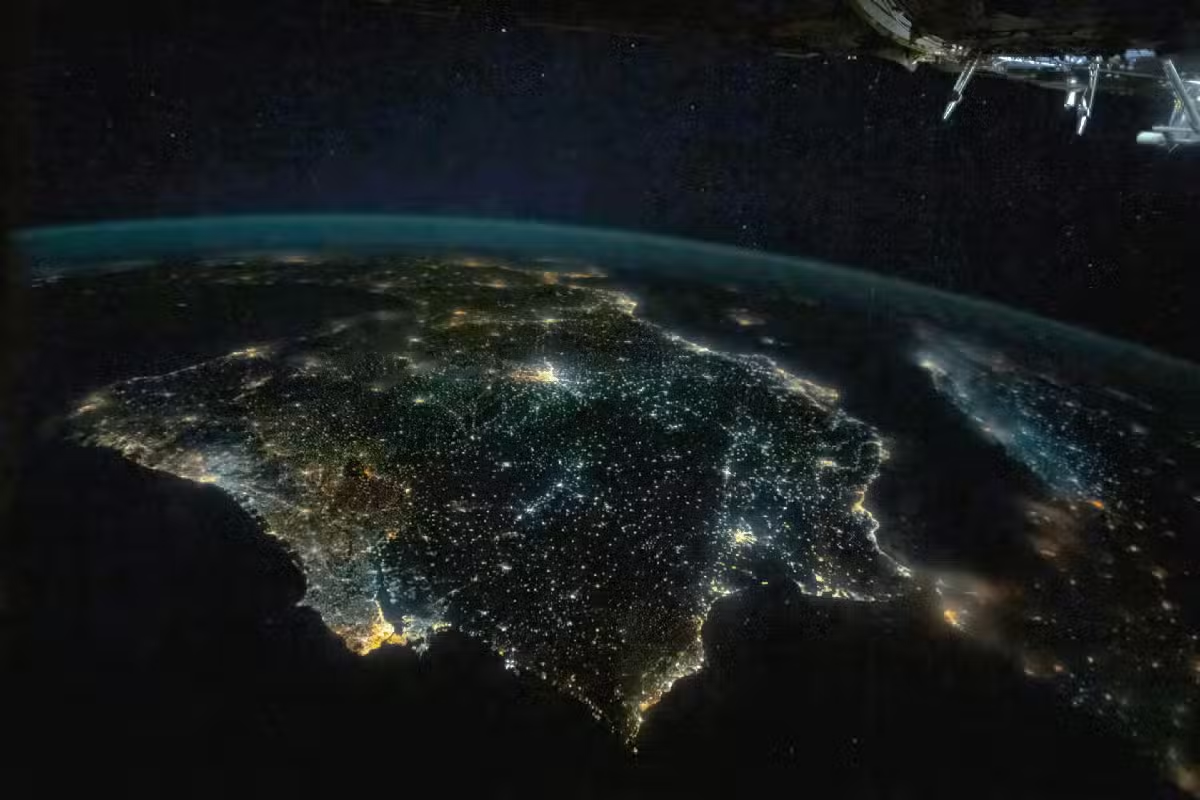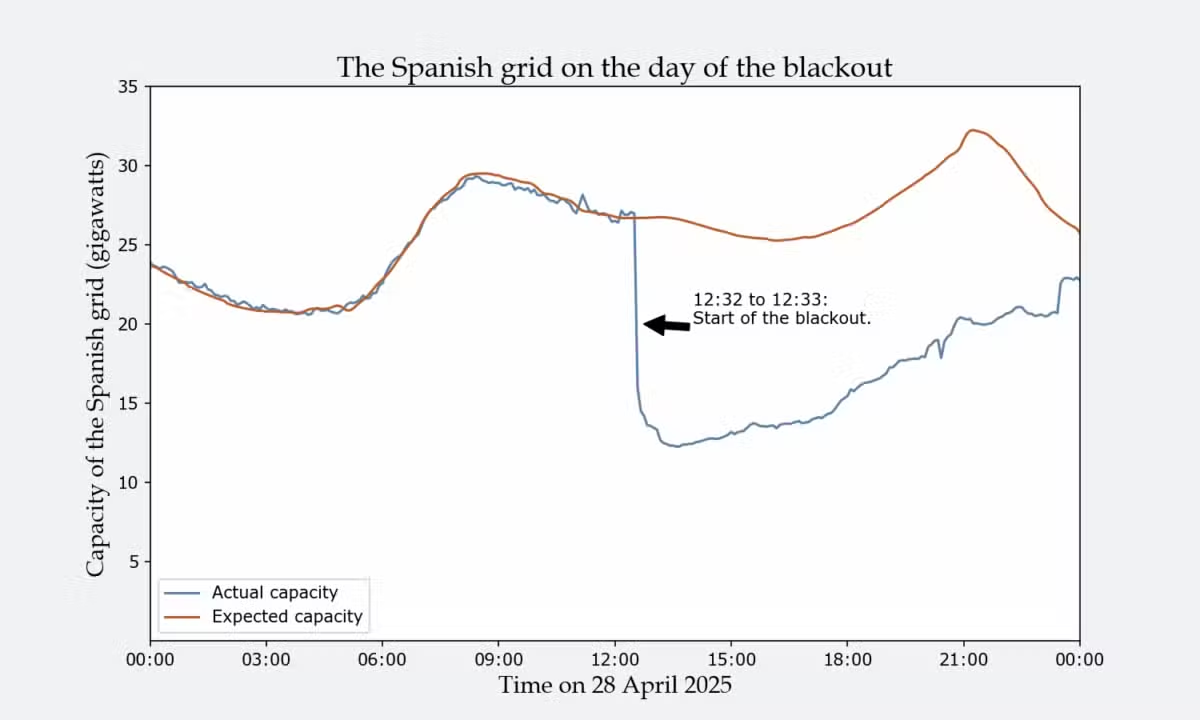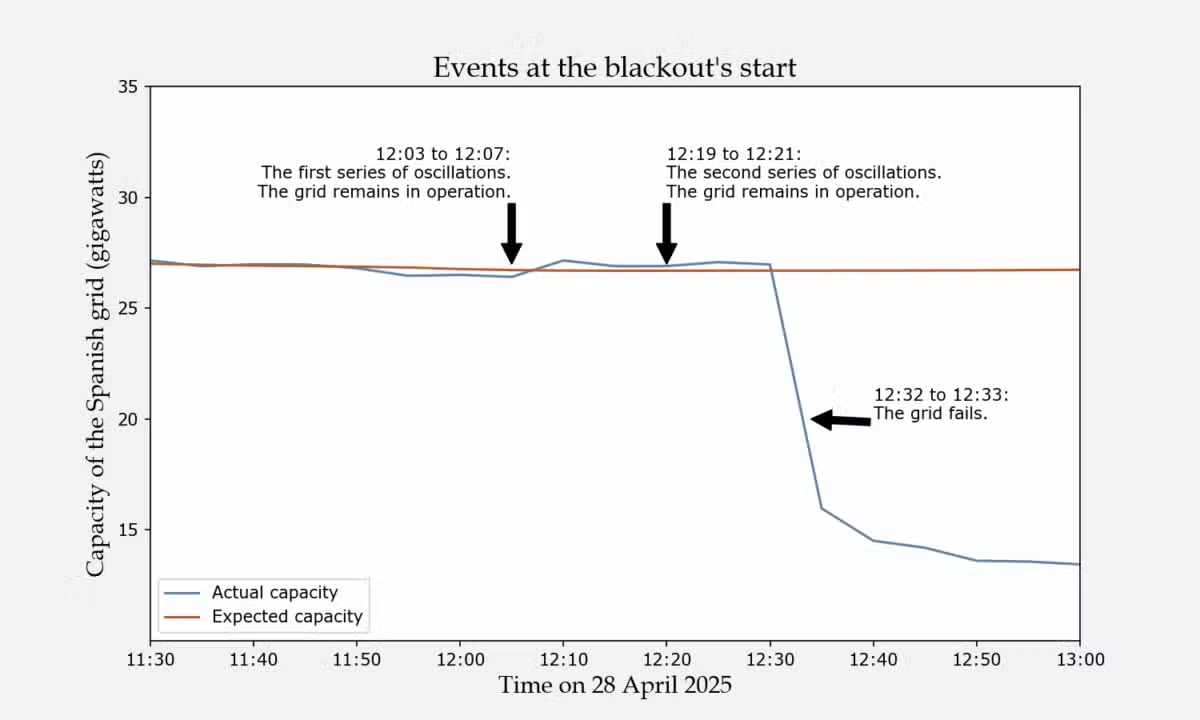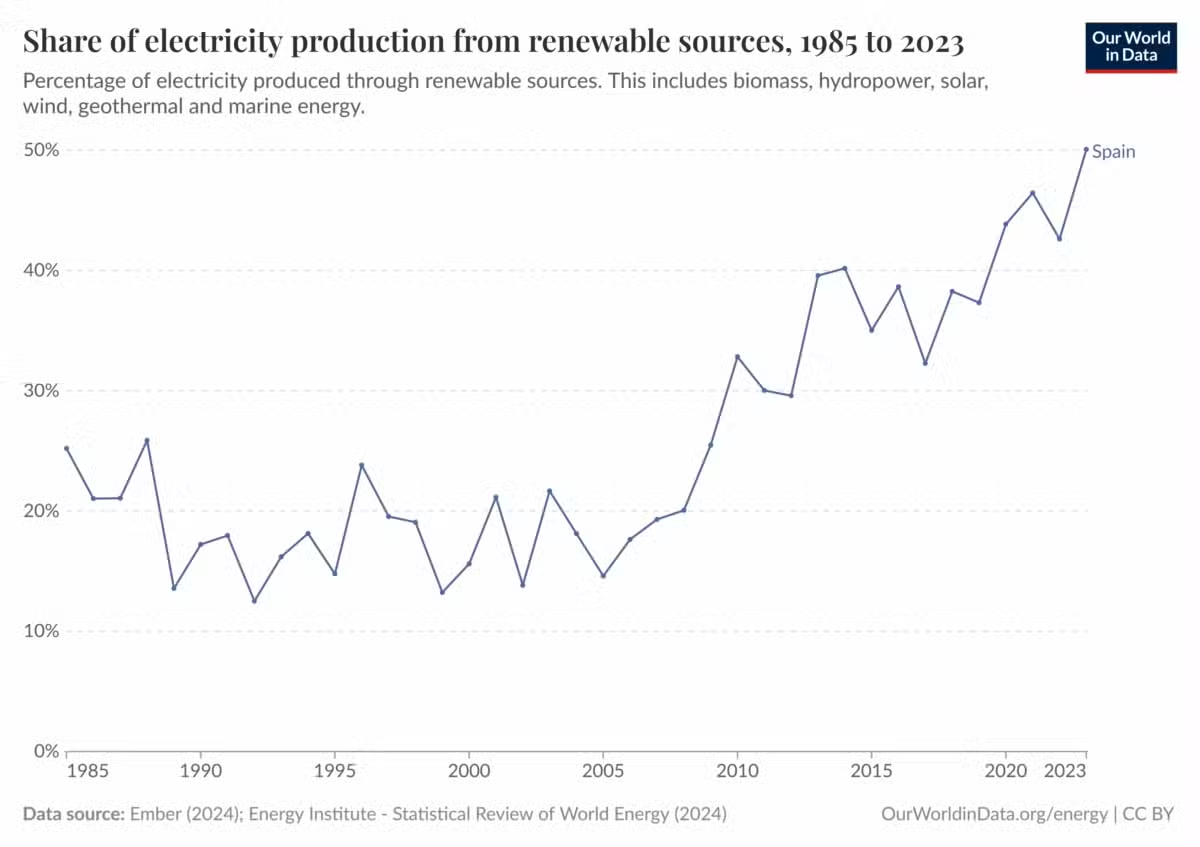- Energy
What caused Iberia’s blackout? Renewable energy’s opponents were quick to blame solar and wind, but multiple factors appear to be at play

Note: This article was updated on 19 June 2025 and later on 14 October 2025 with the results of multiple preliminary investigations into the blackout – see the bottom of the article.
On 28 April 2025, most of Spain and Portugal, as well as Andorra and small areas of southern France, lost access to electricity (Figure 1).
Virtually the entire affected area had been restored to normal within 24 hours. By then, claims had already begun to circulate about the blackout’s cause. Many news outlets and social media users around the world were quick to blame renewables or ‘net zero’ policies for triggering the blackout. Others raised alternative explanations, such as a cyberattack or a solar flare.
Untangling why an electric grid failed is not a simple task – grids are very complex systems with failsafes designed to prevent this exact scenario, and blackouts only tend to happen when multiple things go wrong. It’s usually misleading to blame a blackout on any one cause, even when we do know what happened.
This is the case with the Iberian blackout – investigators continue to analyze the event, and unanswered questions remain, but we can outline the sequence of events that led to the failure. With that in mind, we’ll unpack some of the viral claims that have spread across both print and social media.
Main Takeaways:
- Many claims about the 28 April blackout’s cause, including claims that renewables caused it, were premature.
- Preliminary reports into the blackout indicate that the grid failed due to a voltage surge. Authorities are still investigating the events that led up to this voltage surge, but their findings so far do not suggest that renewables were responsible.
- The blackout instead appears to be an issue with the grid infrastructure. Even if solar farms and wind turbines were involved, blaming them for the blackout is like blaming water for a leaky pipe.
- Electrical grids are very complex systems with many pieces and many failsafes. It is often misleading to point fingers at a single cause for problems. Blackouts tend to happen only when multiple parts of a grid fail at once.
- Fossil fuel supporters and other renewable energy opponents are often quick to blame renewables for problems without evidence – this is no exception.

What we know – and what we don’t know – about the Iberian blackout
We have reports into the blackout from the Spanish government, from REE (Spain’s electrical grid operator), and from ENTSO-E (a pan-European group of grid operators). These reports do not provide a comprehensive cause, but they do allow us to establish a timeline (Figure 2).
The first problem arose about 30 minutes before the power actually failed:
- 12:03-12:07: The Spanish grid experienced a series of unplanned oscillations – the frequency of the current flowing through the grid repeatedly rose and fell.
A grid’s frequency (as we describe under “Why frequency matters for electric grids and renewables” below) is how quickly its alternating current’s direction switches. An ideal grid has a constant frequency, but in the real world small oscillations do happen. In fact, the Spanish grid was already experiencing small oscillations, which are normal across Europe.
The oscillations that began at 12:03 were much larger. Engineers know well how to dampen these sorts of oscillations, and Spanish grid operators reacted accordingly. Their actions caused the grid’s voltage to slightly rise.
This isn’t desirable – an ideal grid’s voltage should also be constant – but here, the voltage stayed in the grid’s normal range. The grid remained in operation. - 12:19-12:21: The grid experienced a second series of large oscillations. REE noted that these oscillations were especially severe at one particular solar plant in Badajoz, in Spain’s southwest – but it’s unclear whether the solar farm had anything to do with causing the oscillations.
Again, the Spanish grid operator reacted to damp the oscillations – rearranging electric connections and reducing the amount of electricity exported from the country. Again, these actions caused the grid’s voltage to rise slightly, but it still remained within the safe range.
The grid kept functioning normally. - 12:30: As the grid recovered from the second set of oscillations, its voltage continued on a rising trend. Although it was still within the grid’s normal range, operators tried to bring the voltage in check by connecting more large power plants to the grid.
This is a typical method of controlling voltage, but as we’ll describe later, it ultimately failed. - 12:32-12:33: The grid must keep a relatively stable voltage – a voltage that’s too low or too high may trigger failsafes.
That seems to have happened on the day of the blackout – the voltage rose beyond typical limits, causing numerous generators in the south of Spain to ‘trip’, or abruptly disconnect from the grid. These generators were connected to multiple different sources of electricity, not just solar panels and wind turbines.
Reports blame this rise in voltage for the blackout. It isn’t clear what caused it, but there’s nothing about solar panels or wind turbines that would have caused it. - 12:33: The voltage of the Iberian peninsula’s electric grid continued to rise, and its frequency began to drop (we’ll discuss what this means in the next section). Automatic systems, trying to keep the grid active, shut down power in some areas and shut off the links connecting Spain to France and the rest of Europe’s grid.
This was not successful – less than 30 seconds later, the entire peninsula lost electricity.

Electrical operators immediately began trying to restore normalcy – by 12:44, they had already begun restoring power in some regions by re-electrifying connections between Spain and France. Within about 16 hours, by the next morning, the grid had been fully restored in all of Spain and Portugal.
Even after the reports, there are still some questions that remain unanswered. We don’t know why that solar plant in Badajoz experienced a more severe oscillation than elsewhere – did a fault with the solar farm cause the oscillation, or did something else happen? We also don’t know if any role was played by small oscillations coursing through the grid before the large oscillations began.
Lastly, the grid should have been able to keep its voltage under control – we don’t entirely know why it couldn’t.
Why voltage matters for electric grids and renewables
Multiple reports blame that voltage surge for causing the Spanish blackout. Even if something did go wrong in a solar farm at Badajoz, it’s misleading to blame the blackout on renewables, because other parts of the complex power grid should have been able to control the voltage.
Traditionally, this control has been the purview of large power plants – whether they’re powered by coal, gas, or nuclear reactors. These large generators can absorb power from the grid or inject power into the grid, cancelling out any voltage fluctuations as needed.
However, for some reason, large power plants couldn’t perform this function on the day of the blackout. Miguel de Simón Martín, Professor of Electrical Engineering at the University of León, told Science Feedback:
“For some reason that the report does not make clear, the generators assigned to perform this function did not heed the instructions of the system operator (REE) to do so. I cannot say for sure that if they had intervened the collapse would not have occurred, but it certainly would have been an effective measure to try to avoid it.”
It might seem logical to blame grids dependent on solar or wind for lacking enough voltage control, but this is a misleading conclusion. Engineers are well aware of ways that grids dependent on solar or wind can control voltage.
However, Spain’s grid wasn’t using those methods due to outdated rules. Miguel de Simón Martin noted to Science Feedback that the relevant technical specs, guiding how the Spanish grid controls voltage, hadn’t been updated since 2000. Those specs didn’t account for solar and wind – at the time, solar and wind together comprised less than 3% of Spain’s electricity mix.
That figure has risen to 43% today. Fortunately, those technical specs are now being updated.
Why frequency matters for electric grids and renewables
Again, multiple reports blame a voltage surge for causing the Spanish blackout.
In the days after the blackout, however, engineers poring over public data noticed that the grid’s collapse at 12:32-12:33 corresponded with a drop in its frequency. Many commentators speculated that this frequency drop may have been a fingerprint of the blackout’s cause.
Many claims were quick to point fingers, noting that Spain’s grid is highly dependent on solar power. This fits a pattern – commentators and fossil fuel supporters are often quick to blame renewables for unfortunate events, without waiting for real evidence. Indeed, more recent reports have pinned the grid collapse on a voltage surge, not a frequency decrease.
The grid uses alternating current (AC), in which the current continually switches the direction of its flow back-and-forth. The opposite of AC is direct current (DC), which only flows in one direction. We use AC on the grid, because it’s easier to change the voltage of AC current, and this allows us to better transmit electricity over long distances.
So, the AC frequency must be maintained if a grid is to operate properly. Seconds before the 28 April 2025 blackout started, the Iberian grid’s frequency dropped from 50 Hz to 48 Hz. This may seem like a small change, but it’s large enough to damage electrical equipment and threaten the entire grid – this is why automated systems were so quick to take action.
Large fossil fuel and nuclear power plants generate power using large turbines, which can keep a regular frequency akin to a metronome keeping tempo. Wind turbines (which are far smaller) and solar panels, however, produce DC. They typically rely on other equipment such as inverters to ensure that their electricity matches the grid frequency.
This is one challenge with adapting electric grids to large amounts of solar and wind. They need equipment to ensure that they can adapt to the grid’s frequency. “Renewable generation sources are not the problem, but they must be used in a way that is compatible with grid capacities”, Miguel de Simón Martín told Science Feedback.
It isn’t an unknown issue – power grid analysts are very well aware of it, and electrical operators plan for it.
Again, what we know about the Spanish blackout doesn’t suggest a lack of inertia was responsible, but there is some precedent for it elsewhere. For example, a 2016 blackout in South Australia may have been caused by a lack of inertia[1]. In that incident, heavy winds from a violent storm damaged critical transmission lines, and the grid could not maintain its frequency, resulting in the entire state losing electricity.
A 2019 blackout in the United Kingdom occurred when, thanks to lightning striking a transmission line, two major power stations disconnected from the grid at the same time. The frequency dropped from its usual 50 Hz to 48.8 Hz, and the grid responded by automatically offloading around 1 million customers. This was enough to keep the grid in order – most of the UK’s lights stayed on, and those who did lose power regained it within 45 minutes.
Grids can run on renewables
It’s misleading to say that blackouts caused by a lack of inertia, such as the examples in the last section, are ‘caused by renewables’. This is an issue with the grid infrastructure – blaming solar panels or wind turbines is akin to blaming water for a leaky pipe.
“There’s nothing wrong with wind and solar which would have caused the blackout. It is just the way we manage them”, Janusz Bialek, Principal Research Fellow at the Control and Power Group at Imperial College London, told Science Feedback.
Furthermore, such claims can leave readers with the impression that adding renewables inherently causes blackouts, which is not the case.
For example, at the time of the Iberian blackout, around midday on 28 April 2025, solar panels accounted for 59% of Spain’s electricity, wind turbines for 12%, nuclear power for 11%, and gas power for around 5%.
This sort of mix isn’t unusual – Spain has generated a high share of its electricity from renewables for years without triggering a major blackout (Figure 3). Indeed, several days earlier, on 16 April 2025, Spain generated enough electricity with solar, wind and hydro to meet 100% of the grid’s demand on a weekday for the first time ever.

There are many other examples of solar- and wind-dependent grids, many of which draw 100% of their electricity from low-carbon sources, which run smoothly even without nuclear. For example, when California’s electric grid ran entirely on hydro, wind, and solar for parts of 98 days in 2024, no blackouts ensued – nor, for that matter, did electricity prices rise[2].
In fact, South Australia has nearly doubled the average share of solar and wind in its grid since its blackout, rising from 41% in 2016 to 72% in 2025. That state hasn’t experienced a blackout on the same level since.
What is true is that a grid that draws electricity from several very large fossil fuel plants cannot operate in the same way as a grid based on many distributed solar panels and wind turbines. Bialek told Science Feedback:
“The problem is that we are living in a transition period from this traditional era of fossil-fuel-based generation to renewable-based energy. We are seeing teething problems. Sometimes, they are dramatic.”
This is why renewable grids need equipment such as inverters to provide inertia. Again, grid operators are well aware of this problem, and inverters are improving. There are other ways of providing inertia in a solar- or wind-heavy grid, such as adding battery storage[3,4].
No evidence for several claims about the Iberian blackout
The Guardian and several other news outlets credited Portugal’s grid operator REN with saying that ‘induced atmospheric vibration’ had caused the blackout – REN later denied having made any such statement. ‘Induced atmospheric vibration’ is not a term that meteorologists or climate scientists use. Atmospheric phenomena can disturb electric infrastructure, but there’s no evidence this happened in Spain. It’s worth noting that the weather in Spain on 28 April 2025 was calm.
Other claims, some of which garnered hundreds of thousands of views on X/Twitter, suggested that the blackout was caused by a “solar flare”, a burst of energy released from the Sun. While powerful solar flares can knock out electrics – this is one reason scientists are always monitoring what the Sun is doing – scientists did not observe a spike in solar activity in the days around 28 April 2025. Moreover, Science Feedback found no evidence that any authoritative source actually blamed a solar flare.
There was also some initial speculation that the blackout was deliberate – the result of an act of sabotage or a cyber attack – but there’s no evidence to support this speculation. Less than a day after the blackout, Spanish and Portuguese authorities denied a cyber attack.
Some accounts spread falsified images of publications such as the Independent and France24 purporting to report that the blackout was a “consequence of European sanctions on Russia” or a result of Russian-made equipment being replaced on the European power grid. These images are fabricated, and some have been linked to known sources of Russian-backed disinformation.
Update: Preliminary investigation results do not say that renewables were responsible for the blackout
On 17 June 2025, the Spanish government released the preliminary results of its investigation into the blackout. According to the report, the blackout was triggered by a surge in the grid’s voltage.
The following day, on 18 June 2025, Red Eléctrica de España (REE) – Spain’s grid operator – released its own report into the blackout. REE’s report also blamed a voltage spike for causing the grid to collapse, though some of the details differed from the government report.
Despite initial reactions that blamed renewables and a lack of inertia, the reports say otherwise. The Spanish government’s report also ruled out cyberattacks or sabotage as causes for the blackout.
Despite initial reactions that blamed renewables and a lack of inertia, the reports say otherwise. They ruled out cyberattacks or sabotage as causes for the blackout.
These findings are corroborated in another preliminary report (in English) released on 3 October 2025 by experts from ENTSO-E (a consortium of European electric grid operators). The ENTSO-E report also offered a more detailed timeline of the events leading up to the blackout. ENTSO-E’s investigators continue to examine the blackout’s causes and intend to release a later, final report.
We have updated this article on 14 October 2025, taking into account these findings.
References
- 1 – Yan et al. (2018) The Anatomy of the 2016 South Australia Blackout: A Catastrophic Event in a High Renewable Network. IEEE Transactions on Power Systems.
- 2 – Jacobson et al. (2025) No blackouts or cost increases due to 100 % clean, renewable electricity powering California for parts of 98 days. Renewable Energy.
- 3 – Curto et al. (2022) Grid Stability Improvement Using Synthetic Inertia by Battery Energy Storage Systems in Small Islands. Energy.
- 4 – Ahmed et al. (2023) Dynamic grid stability in low carbon power systems with minimum inertia. Renewable Energy.



